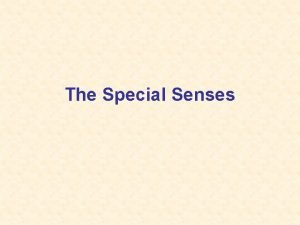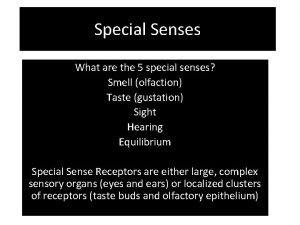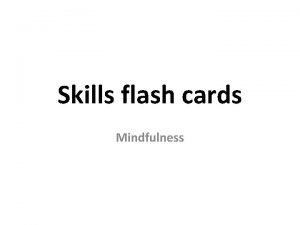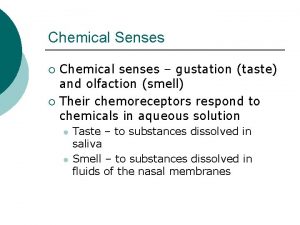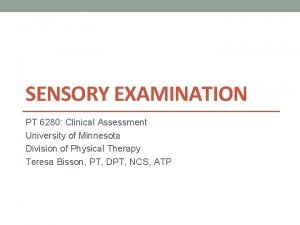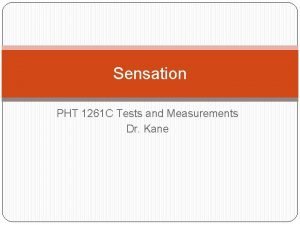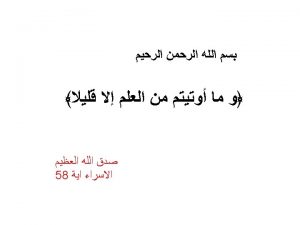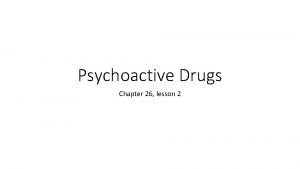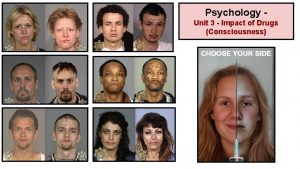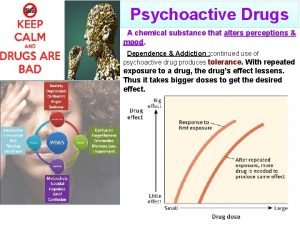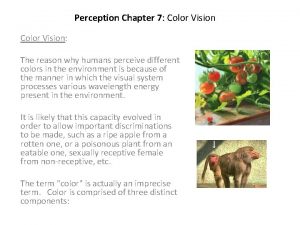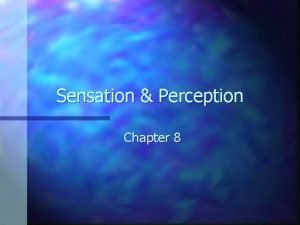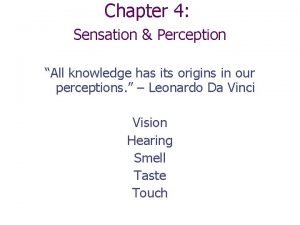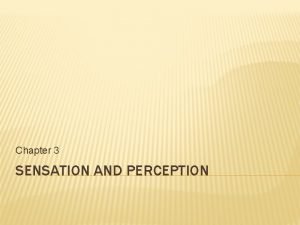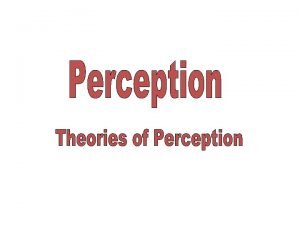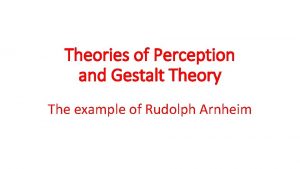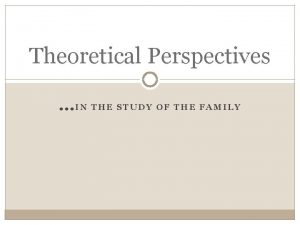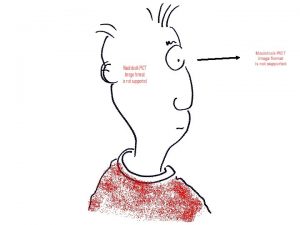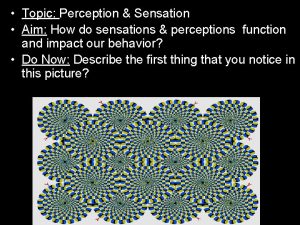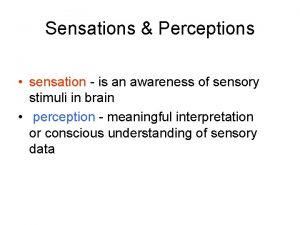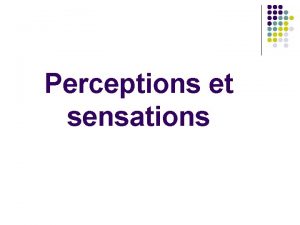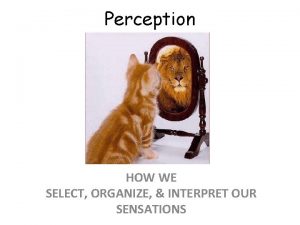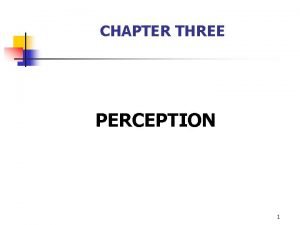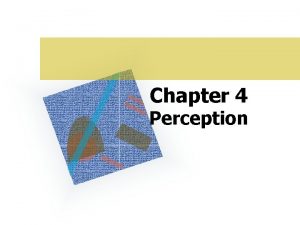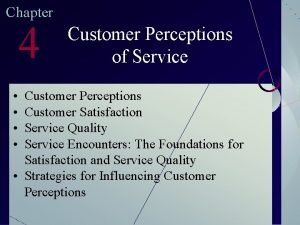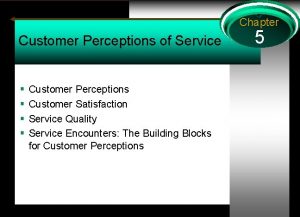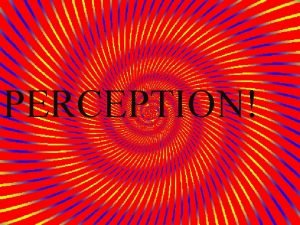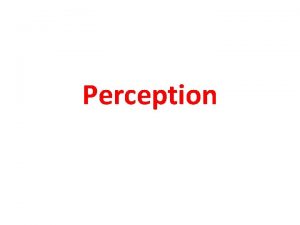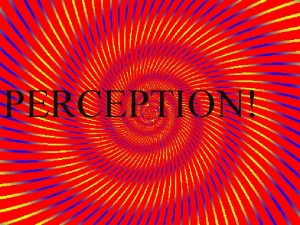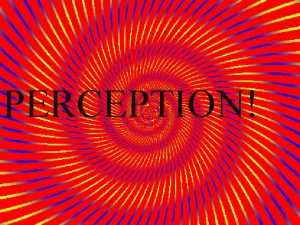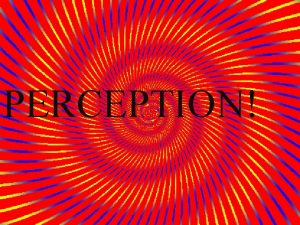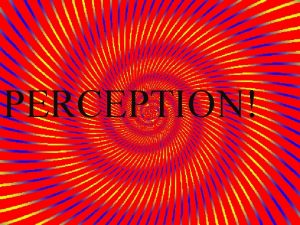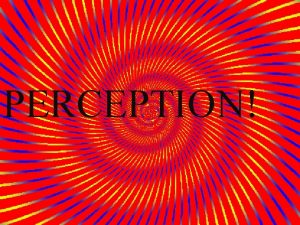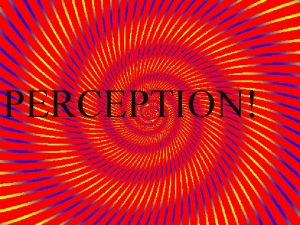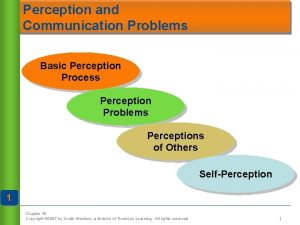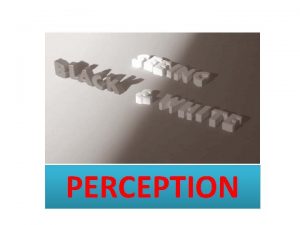Chapter 5 PERCEPTION Sensations vs Perceptions Perception n



























- Slides: 27

Chapter 5 PERCEPTION

Sensations vs. Perceptions Perception n Our interpretations of the real world How do Sensations Become Perceptions n n A perception begins with some stimulus which activates sense receptors Once activated, a sense organ transforms energy into electrical signals or impulses that travel to the brain

Sensations vs. Perceptions (continued) Parts of the Brain transform electrical signals into basic sensations Sensations are your first experiences of outside stimuli n They consist of meaningless bits of sensory information Each of us has a unique set of experiences that may automatically add meanings, feelings, or memories to our perceptions

Sensations vs. Perceptions (continued) The brain automatically assembles many thousands of individual sensations into a meaningful pattern or image which is called perception n Personalized interpretations rather than true copies of things in the real world

Enduring Issues in Perception Role of Learning n Newborns’ senses are all functional and some degree of perceptual ability is probably innate

Enduring Issues in Perception (con’t) Parts vs. the Whole n Feature Analysis w The theory that we perceive a form on the basis of a relatively small collection of features, which can be combined, rotated and expanded (Structuralism)

Enduring Issues in Perception (con’t) Gestalt School n n Psychologists who believe that a meaningful overall pattern (Gestalt) is perceived before its parts are recognized “The whole is more than the sum of its parts”

Enduring Issues in Perception (con’t) Perceptual Illusions n Used to determine how people process perceptual information Bottom-Up vs. Top-Down Processing n n n Bottom-Up: sensory receptors to brain Top-Down: perceiver’s expectations & context play a role from the beginning Perceptual Sets: w learned expectations that are based on our personal social or cultural experiences. These expectations change or bias what we see.

Functions of Perception Where is it? – Location n Attention w Automatic – distinguishing object from background w Deliberate – allocation of attention n Depth Perception w Ability to experience depth in visual perception (relative & absolute distances)

Functions of Perception: Depth Perception (continued) Binocular Depth Cues – depend upon the movement of both eyes n n Convergence – based on signals sent from the muscles that turn the eyes Binocular (Retinal) Disparity – depends on the distance between the eyes w Stereopsis w 3 -D Glasses

Functions of Perception: Depth Perception (continued) Monocular Depth Cues n n Depend upon the signals sent from one eye Determined by how objects are arranged in the environment

Functions of Perception: Depth Perception (continued) Motion Parallax Relative Size Constancy Linear Perspective Texture Gradient Aerial Perspective Occlusion (Interposition)

Functions of Perception (continued) Illusions of Depth n n Muller-Lyer, Ponzo, Ames Room, Vista Paradox (pg. 146) If our perceptual cues are changed, our otherwise reliable perceptual processes can be deceived

Functions of Perception (continued) Auditory Localization n Differences in how and when a sound reaches the two ears enable the brain to compute the location of its source

Functions of Perception (continued) Is it Moving? – Movement n Motion Perception w We distinguish between changes in environment that are caused by movements in the environment and changes that are caused by our own movements

Functions of Perception (continued) Illusions of Motion n Apparent Motion (Phi Phenomenon) Induced Motion (moon appears to move through clouds) Motion Aftereffect (train stops and objects outside appear to move backwards)

Functions of Perception (continued) What is It? – Form n Feature Analysis w Involves the recognition of features (lines, intersections & corners) as well as location, orientation, contrast, and fuzziness. w Features are grouped into clusters

Functions of Perception (continued) Gestalt View (Principles) n Figure-Ground Distinction w In organizing stimuli, we tend to automatically distinguish between a figure and a ground w The figure with more detail, stands out against the background, which has less detail

Functions of Perception (continued) Gestalt View (continued) Grouping n n n Similarity Proximity Continuity Simplicity Closure

Subliminal Perception Subliminal Messages n n Brief auditory or visual messages that are presented below the absolute threshold, which means that there is a <50% chance that they will be perceived Although subliminal messages may be ineffective in changing behavior, there is evidence that emotions may unknowingly or subliminally influence perception

Cultural Diversity: Changing Perceptions Besides affecting social and personal values, cultural influences can also affect our perception of color depth, constancy, and motion

ESP: Extrasensory Perception A group of psychic experiences that involve perceiving or sending information outside normal sensory processes or channels n Includes 4 general abilities w Telepathy w Precognition w Clairvoyance w Psychokinesis

ESP: Extrasensory Perception (con’t) Most academic psychologists do not yet accept the existence of psychic powers or extrasensory perception, which are collectively called psi phenomena n n Trickery Questionable methodology (unreliable scientific procedures)

Application: Creating Perceptions Creating Reality n Virtual Reality w A perceptual experience of being inside an object, moving through an environment, or carrying out some action – that is entirely simulated by a computer

Application: Creating Perceptions (continued) Creating Impressions n n Social psychologists have concluded that facial features have a significant affect on our first impressions of people First impressions are also influenced by racial stereotypes, both positive and negative, based on physical features such as skin and hair color

Life-Span Changes in Perception Sensory World of Infant n n A newborn’s distance senses (sight & hearing) are not as developed as the sense of touch, smell & taste Sight is probably the least developed sense w They have poor depth perception and are unable to see the full color spectrum n By the age of 7 months, babies’ vision & hearing are acute

Life-Span Changes in Perception The Aging Senses n n n Sensory systems begin aging during the 40 s and may become severe by the 70 s and 80 s Life in a noisy environment may contribute to hearing loss Medication may reduce taste sensitivity
 Five basic taste sensations
Five basic taste sensations What are the special senses
What are the special senses Mindfulness examples
Mindfulness examples Primary taste sensations
Primary taste sensations Five basic taste sensations
Five basic taste sensations Five basic taste sensations
Five basic taste sensations To study inner sensations images and feelings
To study inner sensations images and feelings Cortical sensations
Cortical sensations Cortical sensations
Cortical sensations Perception in psychology
Perception in psychology Difference between fine touch and crude touch
Difference between fine touch and crude touch Drug that alters moods, thoughts, and sense perceptions
Drug that alters moods, thoughts, and sense perceptions Trust your perceptions
Trust your perceptions Drugs that alter moods thoughts and sense perceptions
Drugs that alter moods thoughts and sense perceptions Psychedelic drugs that distort perceptions and evoke
Psychedelic drugs that distort perceptions and evoke A chemical substance that alters perceptions and moods.
A chemical substance that alters perceptions and moods. Chapter 5 sensation and perception
Chapter 5 sensation and perception Color vision
Color vision Chapter 3 sensation and perception
Chapter 3 sensation and perception Chapter 6 sensation and perception
Chapter 6 sensation and perception Copyright
Copyright Chapter 8 sensation and perception
Chapter 8 sensation and perception Chapter 7 managing risk vision and perception
Chapter 7 managing risk vision and perception Chapter 4 sensation and perception
Chapter 4 sensation and perception Chapter 3 sensation and perception
Chapter 3 sensation and perception Gregory top down theory of perception
Gregory top down theory of perception Film als kunst
Film als kunst Perspective vs perception
Perspective vs perception
